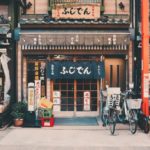Living in Japan’s Fruit Capital, Fukushima

Riding the Tohoku Shinkansen into Fukushima City, the capital of the prefecture infamous for the 2011 earthquake and nuclear accident, you might catch a glimpse of two tanks decorated with massive peaches. You might notice bright pink peaches emblazoned on the manhole covers in the city, and if you visit in late summer, you’ll find gift shops overloaded with peach-flavored candies, cakes, and snacks.
Fukushima is bursting at the seams with peaches, as well as all kinds of other fruit. While Fukushima peaches are the most celebrated, visitors can get their fill of cherries, nashi pears, grapes, and apples from orchards all over the prefecture. Some fruit growers even invite people to pick the fruit themselves.
There’s so much fresh fruit here that, living here, I’ve almost come to take it for granted. While writing this article I’ve received peaches three times and been offered a few more times than that. Just the other day a friend nearly ran me over to stop and give me a bag of peaches. I’m no connoisseur (I had never even had a fresh peach before coming to Japan!) but I’ve gathered that “akatsuki” peaches are unique to Fukushima.
Living in Japan’s Fruit Capital, Fukushima.
They’re as big as a softball and incredibly sweet, but they turn quickly, which is why everyone is in such a rush to give them to friends and neighbors. When I had the opportunity to pick my own fruit, I took home a box full of akatsuki peaches. Unfortunately, they’re so plump and delicate that I could only fit four into a box without crushing them.
Akatsuki peaches are named for the Shinobu Sanzan Akatsuki Mairi festival, in which the Fukushima Waraji (a giant straw sandal) is paraded to the peak of Mount Shinobu to be enshrined at dawn. Akatsuki peaches supposedly evoke the early morning sun. I think an intense mid-afternoon sun would be more fitting, as akatsuki peaches only flourish in Fukushima because of the overwhelmingly hot Fukushima basin. Surrounded on all sides by mountains, central Fukushima and surrounding towns are cursed with boiling hot summers, perfect for fruit cultivation.
There’s so much fresh fruit here in Fukushima that, living here, I’ve almost come to take it for granted.
Stepping into one of Fukushima’s peach fields in August is like stepping into a sauna fully dressed. The day I went peach picking, I was on a tour with ten or so other Americans. Most of us were wearing shorts and t-shirts, and wrapped our sneakers in plastic before stepping into the muddy orchard. The farmers I’ve seen since wear proper rain boots, full length pants and shirts with sleeves tucked into white gloves. Women often wear black ski masks and arm-length gloves made of a cool fabric.
Fukushima’s grape orchards are a bit cooler, if only because peak grape season doesn’t begin until late August or early September. The ground is not so muddy that you need to wrap your shoes in plastic, but some people need to bend a bit to fit under the ceiling of grape vines. Many of the grape orchards in my area are in hilly areas. Since the plants themselves hang above the ground anyway, farmers seem to delegate grapes to the far corners of the valleys, saving the flat patches of land for rice paddies and groves of peach, pear, apple, and other fruit trees.
The steep terrain makes for tough work. After the grapes have flowered in the early summer, the farmers place bags over each bunch of grapes to protect them from insects and the sun. Not many are used for wine production. Rather, the appearance of Fukushima’s grapes is essential, and farmers compete to create the most beautiful grapes, to be eaten just as they are.
Living in Japan’s Fruit Capital, Fukushima.
There are generally three types of Japanese grapes: the reddish Delaware grapes, the dark purple Kyoho variety, and the bright green Shine Muscat grapes. While Kyoho grapes are juicy and have a thick skin, Delaware and Shine Muscat grapes have very few seeds (sometimes none at all), and have thin skins, meaning they can be eaten whole. Shine Muscat grapes are undoubtedly the most popular.
While teaching a class of kindergarten students the English word for grape, I once asked for the word in Japanese and instead of budou the word muscatt was shouted to me. I’m not sure if this would happen in the cities. It might be a quirk particular to children raised in and around their grandparents’ fields.
Living in Japan’s fruit capital, Fukushima, has been a truly delicious experience.
Photo for Living in Japan’s Fruit Capital, Fukushima by Pixabay.








